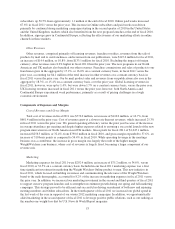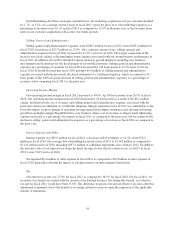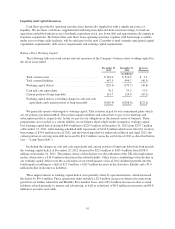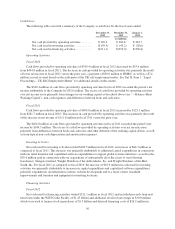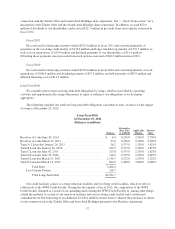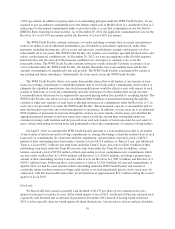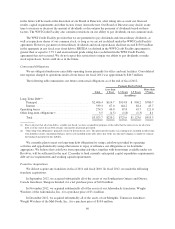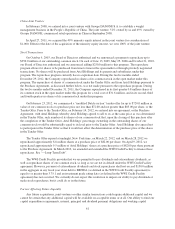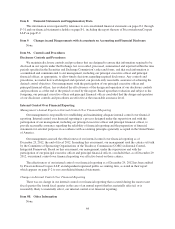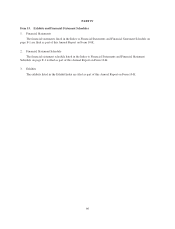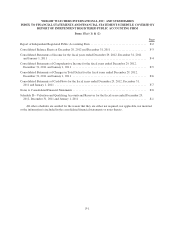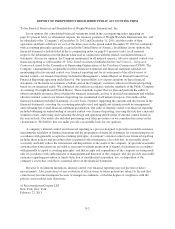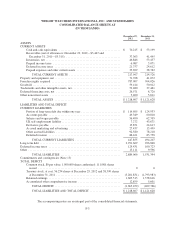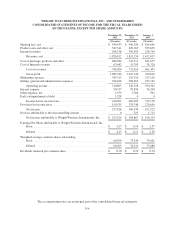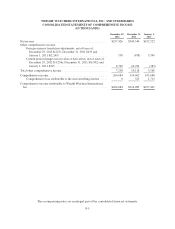WeightWatchers 2012 Annual Report Download - page 79
Download and view the complete annual report
Please find page 79 of the 2012 WeightWatchers annual report below. You can navigate through the pages in the report by either clicking on the pages listed below, or by using the keyword search tool below to find specific information within the annual report.presentation of reclassification adjustments out of accumulated other comprehensive income. The Company
adopted the provisions of this guidance in the first quarter of fiscal 2012, and such adoption did not affect the
consolidated financial position, results of operations or cash flows of the Company.
In May 2011, the FASB issued authoritative fair value guidance entitled “Fair Value Measurement:
Amendments to Achieve Common Fair Value Measurement and Disclosure Requirements in U.S. GAAP and
IFRSs”. Some of the amendments included in the guidance clarify the FASB’s intent about the application of
existing fair value measurement requirements. Other amendments change a particular principle or requirement
for measuring fair value or for disclosing information about fair value measurements. This guidance is effective
for interim and annual periods beginning after December 15, 2011. The Company adopted the provisions of this
guidance in the first quarter of fiscal 2012, and such adoption did not have a material impact on the disclosures in
its consolidated financial statements.
Item 7A. Quantitative and Qualitative Disclosures about Market Risk
We are exposed to market risks relating to interest rate changes and foreign currency fluctuations. As of the
end of fiscal 2012, other than as described below, there have been no material changes to the Company’s
exposure to market risk since the end of fiscal 2011.
Interest Rate Risk
Our exposure to market risk for changes in interest rates relates to interest expense of variable rate debt. As
of the end of fiscal 2012, we had entered into interest rate swaps with notional amounts totaling $583.3 million to
hedge a portion of our variable rate debt. As of such date, $1,823.1 million of our variable rate debt remained
unhedged. Our interest rate swap that went effective on January 4, 2010 and terminates on January 27, 2014 had
an initial notional amount of $425.0 million, which amount will fluctuate during the remainder of its term to a
maximum of $583.3 million. Changes in the fair value of these derivatives will be recorded each period in
earnings for non-qualifying derivatives or accumulated other comprehensive income (loss) for qualifying
derivatives. Based on the amount of our variable rate debt and interest rate swap agreements as of the end of
fiscal 2012, a hypothetical 50 basis point increase or decrease in interest rates on our variable rate debt would
increase or decrease our annual interest expense by approximately $9.1 million. This change in market risk
exposure from the end of fiscal 2011 was driven by the additional borrowings in connection with the repurchases
of shares of common stock under the Tender Offer and from Artal Holdings. See “Item 7. Management’s
Discussion and Analysis of Financial Condition and Results of Operations—Liquidity and Capital Resources—
Stock Transactions” for additional information on these share repurchases.
Foreign Currency Risk
Other than inter-company transactions between our domestic and foreign entities, we generally do not have
significant transactions that are denominated in a currency other than the functional currency applicable to each
entity. As a result, substantially all of our revenues and expenses in each jurisdiction in which we operate are in
the same functional currency. In general, we are a net receiver of currencies other than the US dollar.
Accordingly, changes in exchange rates may negatively affect our revenues and gross margins as expressed in
US dollars. In the future, we may enter into forward and swap contracts to hedge transactions denominated in
foreign currencies to reduce the currency risk associated with fluctuating exchange rates. Realized and unrealized
gains and losses from any of these transactions may be included in net income for the period.
Fluctuations in currency exchange rates, particularly with respect to the euro and pound sterling, may
impact our shareholders’ equity. The assets and liabilities of our non-US subsidiaries are translated into
US dollars at the exchange rates in effect at the balance sheet date. Revenues and expenses are translated into
US dollars at the average exchange rate for the period. The resulting translation adjustments are recorded in
shareholders’ equity as a component of accumulated other comprehensive income (loss). In addition, exchange
rate fluctuations will cause the US dollar translated amounts to change in comparison to prior periods.
63


